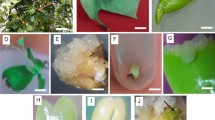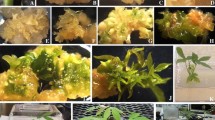Abstract
Somatic embryos were induced on roots excised from in vitro plants of Prunus avium× pseudocerasus `Colt'. On medium containing 6-benzylamino purine (BAP, 1.5 μM) and 2,4-dichlorophenoxyacetic acid (2,4-D, 15 μM), a mean of 25 (s.e. ± 2.0) somatic embryos were produced on intact root systems and 15 (s.e. ± 1.7) on roots systems cut into 10 mm pieces. Most somatic embryos were formed directly on intact roots and indirectly (from callus) on sectioned roots. A mean of 2.5 (s.e. ± 0.25) secondary embryos per primary embryo were formed directly on primary embryos after they were transferred to medium containing BAP (1.5 μM), indole-3-butyric acid (10 μM) and 2,4-D (5 μM). After transfer to a medium containing BAP (2 μM) and gibberellic acid (GA3, 3 μM), shoots developed in 75% (s.e. ± 7.3) of the embryos. Somatic embryos were not induced on explants of in vitro roots or shoots of P. avium, and were induced infrequently on zygotic embryos, although a wide range of media were tested. Possible reasons for the contrasting embryogenic ability of `Colt' and P. avium are discussed.
Similar content being viewed by others
References
De March G, Grenier E, Miannay N, Sulmont G, David H & David A (1993) Potential of somatic embryogenesis in Prunus avium immature zygotic embryos. Plant Cell Tiss. Org. Cult. 34: 209–215
Driver JA & Kuniyuki AH (1984) In vitro propagation of Paradox walnut rootstock. HortSci. 9: 507–509
Feucht W & Dausend B (1976) Root induction in vitro of easy-toroot Prunus pseudocerasus and difficult-to-root Prunus avium. Scient. Hort. 4: 49–54
Genstat 5 Committee (1993) Genstat Reference Manual. Clarendon Press, Oxford
Garin E, Grenier E & Grenier-De March G (1997) Somatic embryogenesis in wild cherry (Prunus avium). Plant Cell Tiss. Org. Cult. 48: 83–91
Gutierrez Pesce P, Taylor K, Muleo R & Rugini E (1998) Somatic embryogenesis and shoot regeneration from transgenic roots of the cherry rootstock 'Colt' (Prunus avium _ P. pseudocerasus) mediated by pRi 1855 T-DNA of Agrobacterium rhizogenes. Plant Cell Rep. 17: 574–580
Hammatt N (1999) Delayed flowering and reduced branching in micropropagated mature wild cherry (Prunus avium L.) compared with rooted cuttings and seedlings. Plant Cell Rep. 18: 478–484
Hammatt N & Grant NJ (1993) Apparent rejuvenation of mature wild cherry (Prunus avium L.) during micropropagation. J. Plant Physiol. 141: 341–346
Hammatt N & Grant NJ (1998) Shoot regeneration from leaves of P. serotina Ehrh. (black cherry) and P. avium L. (wild cherry). Plant Cell Rep. 17: 526–530
James DJ, Passey AJ & Malhotra SB (1984) Organogenesis in callus derived from stem and leaf tissues of apple and cherry rootstocks. Plant Cell Tiss. Org. Cult. 3: 333–341
James DJ, Mackenzie KAD & Malhotra SB (1987) The induction of hexaploidy in cherry rootstocks using in vitro regeneration techniques. Theor. Appl. Genet. 73: 589–594
Jones OP, Gayner GA & Watkins R (1984) Plant regeneration from callus tissue cultures of the cherry rootstock 'Colt' (Prunus avium _ pseudocerasus) and the apple rootstock M.25 (Malus pumila). J. Hortic. Sci. 59: 463–467
Kingswell G (1998) Wild cherry (Prunus avium L.)-the bene-fits and costs of planting genetically improved stock. In: Davey MR, Alderson PG, Lowe KC & Power JB (eds) Tree Biotechnology: Towards the Millenium (pp 23–30). Nottingham University Press, Nottingham
Mandegaran Z & Roberts AV (1998) Regeneration of plantlets from roots of cherry by somatic embryogenesis. In: Davey MR, Alderson PG, Lowe KC & Power JB (eds) Tree Biotechnology: Towards the Millenium (pp 65–68). Nottingham University Press, Nottingham
McCown BH & Lloyd G (1980) Woody plant medium (WPM)-a mineral nutrient formulation for microculture of woody plantspecies. HortSci. 16: 453
Merkle SA, Parrott WA & Williams EG (1990) Applications of somatic embryogenesis and embryo cloning. In: Bhojwani SS (ed) Plant Tissue Culture: Applications and Limitations (pp 67–101). Elsevier, Amsterdam
Murashige T & Skoog F (1962) A revised medium for rapid growth and bioassays with tobacco tissue cultures. Physiol. Plant. 15: 473–497
Smith EF, Roberts AV & Mottley J (1990) The preparation in vitro of chrysanthemum for transplantation to soil 3. Improved resistance to desiccation conferred by reduced humidity. Plant Cell Tiss. Org. Cult. 21: 141–145
Yang HY & Schmidt H (1992) Untersuchungen zur Adventivsproßregeneration in vitro bei Kirschen. II. Adventivsproßbildung an in vitro-Blättern verschiedener Prunus avium-Idiotypen. Gartenbauwissenschaft 57: 7–10
Author information
Authors and Affiliations
Rights and permissions
About this article
Cite this article
Mandegaran, Z., Roberts, A. & Hammatt, N. The ability of Prunus avium× P. pseudocerasus `Colt' to form somatic embryos in vitro contrasts with the recalcitrance of P. avium. Plant Cell, Tissue and Organ Culture 59, 57–63 (1999). https://doi.org/10.1023/A:1006476627434
Issue Date:
DOI: https://doi.org/10.1023/A:1006476627434




